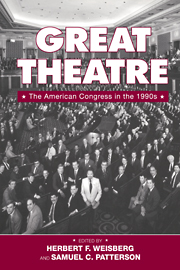Book contents
- Frontmatter
- Contents
- Figures and Tables
- Preface
- Contributors
- Introduction
- Congress and Its Audience
- 2 Representation in Congress: Line Drawing and Minorities
- 3 Unsympathetic Audience: Citizens' Evaluations of Congress
- 4 Back from Intermission: The 1994 Elections and the Return to Divided Government
- Congress at Play
- Congress and Other Actors
- Conclusion
- References
- Index
2 - Representation in Congress: Line Drawing and Minorities
Published online by Cambridge University Press: 20 January 2010
- Frontmatter
- Contents
- Figures and Tables
- Preface
- Contributors
- Introduction
- Congress and Its Audience
- 2 Representation in Congress: Line Drawing and Minorities
- 3 Unsympathetic Audience: Citizens' Evaluations of Congress
- 4 Back from Intermission: The 1994 Elections and the Return to Divided Government
- Congress at Play
- Congress and Other Actors
- Conclusion
- References
- Index
Summary
The process of drawing congressional district boundary lines is crucial to representation in Congress. To a very large extent, districting defines who the actors can be in congressional politics. The ideal of “one person, one vote” was defined initially in the famous U.S. Supreme Court case of Baker v. Carr (1962), and thereby “the reapportionment revolution was born” (Dixon 1968: 3). Three decades after the Baker decision, important issues of congressional representation remain alive, above all, the issue of the representation of African Americans.
The current maelstrom over racial redistricting revisits an old theme in American politics: the inclusionary rules for racial minorities in representative government. These rules define important features of the stage on which the drama of congressional elections unfolds. Ralph J. Bunche once observed that “minority populations, and particularly racial minorities, striving to exist in any theoretically democratic modern society, are compelled to struggle strenuously for even a moderate participation in the democratic game” (quoted in Meier, Rudwick, & Broderick 1965: 184). Bunche knew that representation is intrinsically valuable but not equally attainable by all people in American society. From the debate over slavery at the Constitutional Convention (1787) to recent court decisions such as the 1995 decision in Miller v. Johnson (a case involving racial redistricting in Georgia) and the 1996 Bush v. Vera ruling (a racial-redistricting case in Texas), the United States has struggled to find the appropriate remedy for proven exclusion of racial minorities from the representational process.
Race-conscious districting is the latest remedy for the diminution of minority-vote influence, but it is not without its critics. The case against creating “majority-minority” districts is largely based on three points.
- Type
- Chapter
- Information
- Great TheatreThe American Congress in the 1990s, pp. 33 - 51Publisher: Cambridge University PressPrint publication year: 1998
- 4
- Cited by



